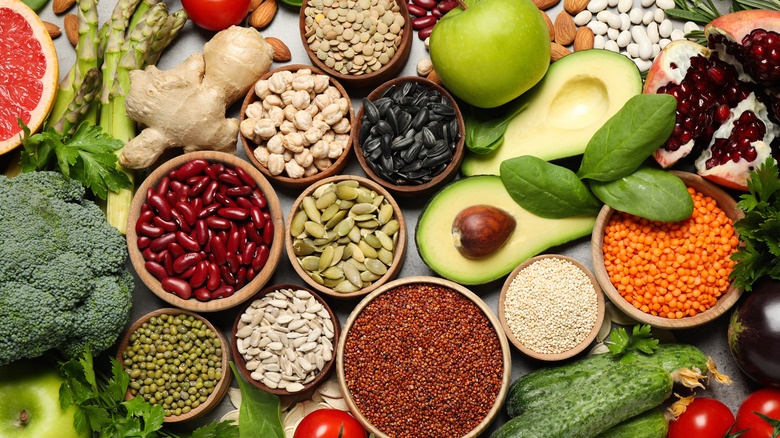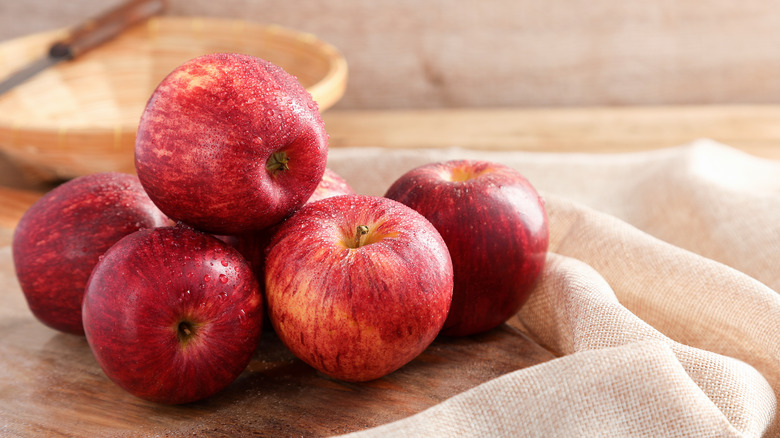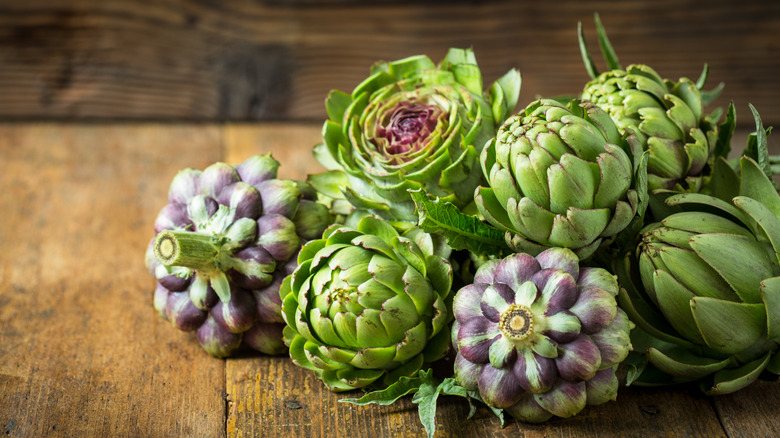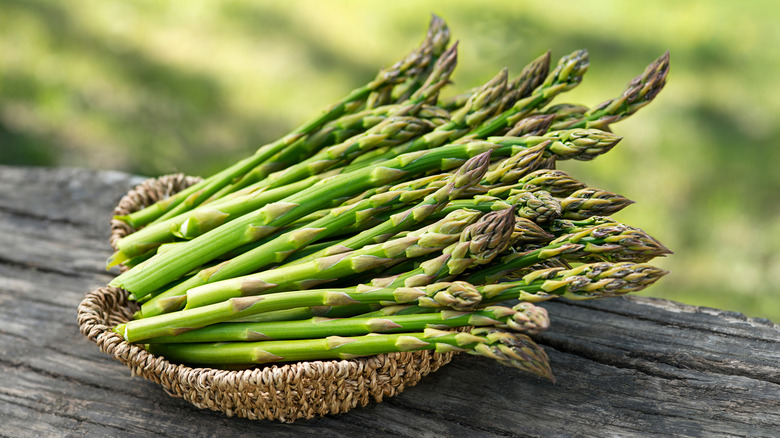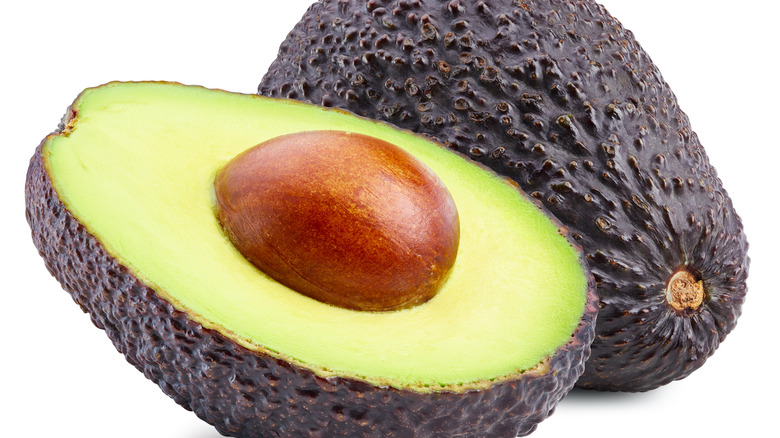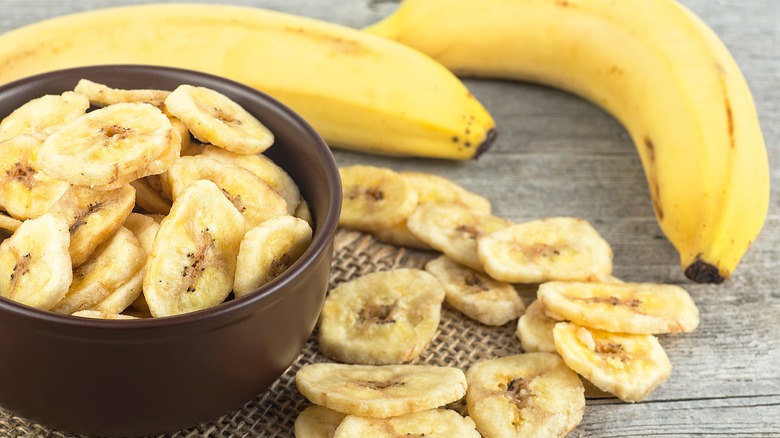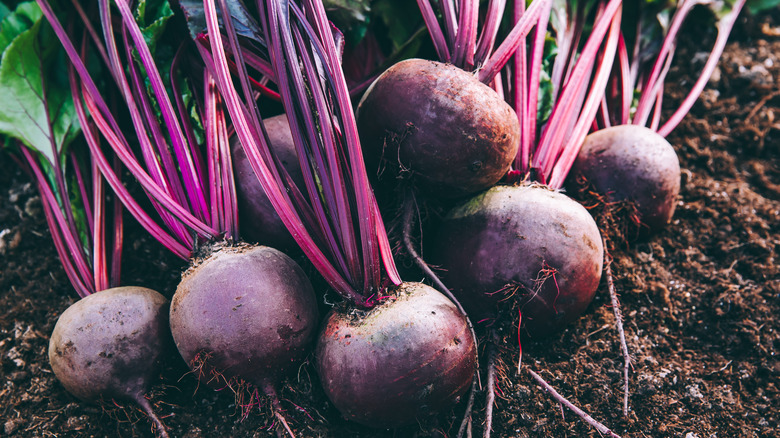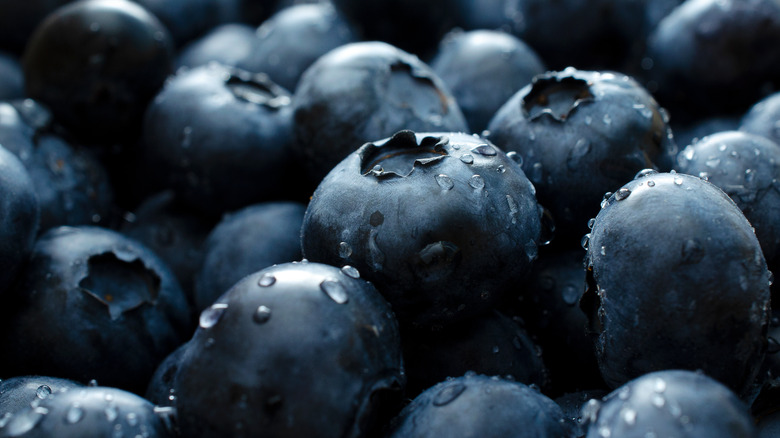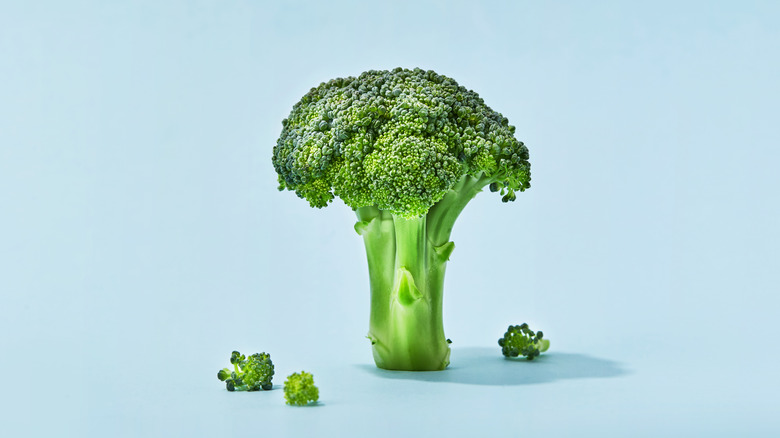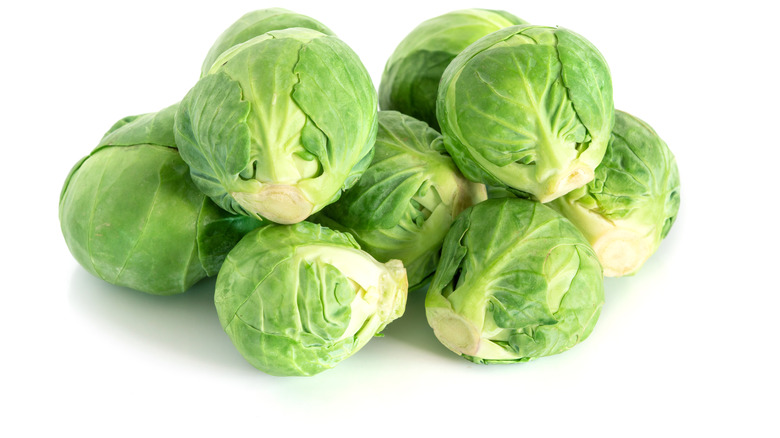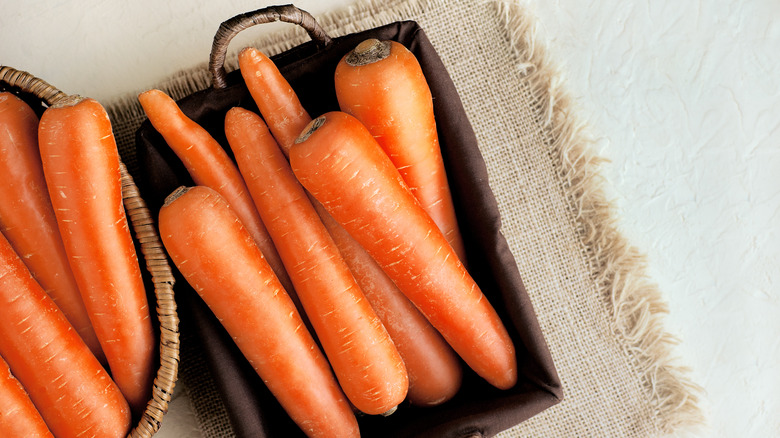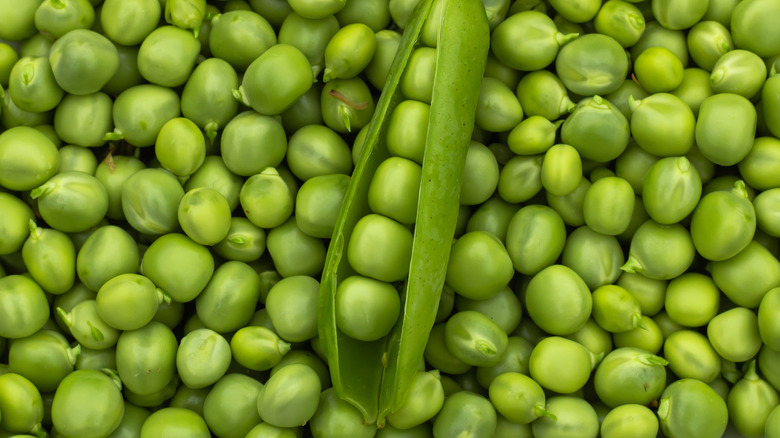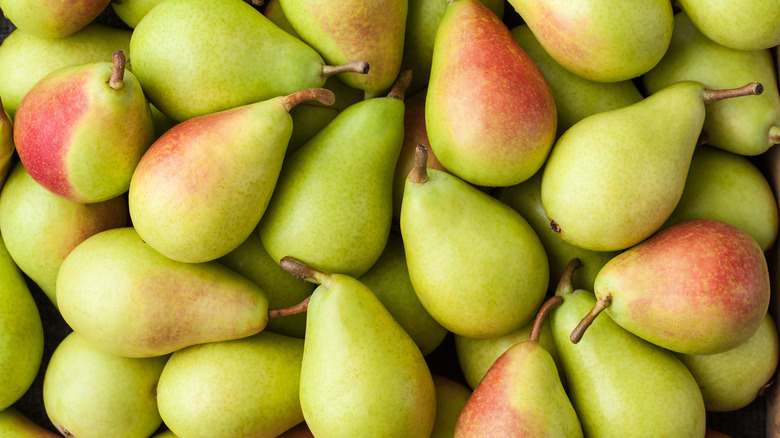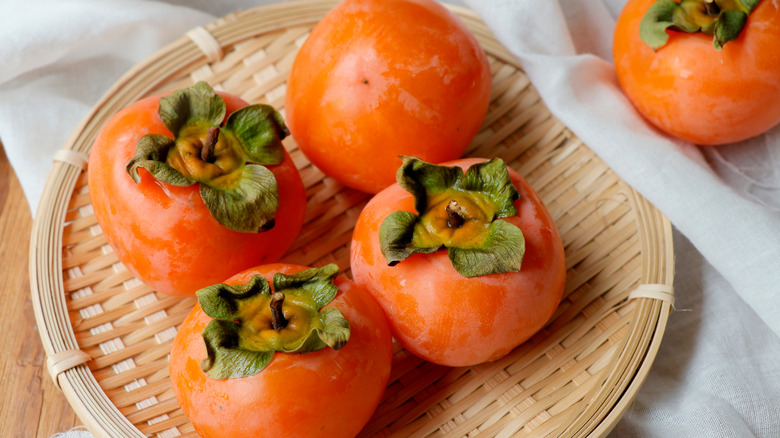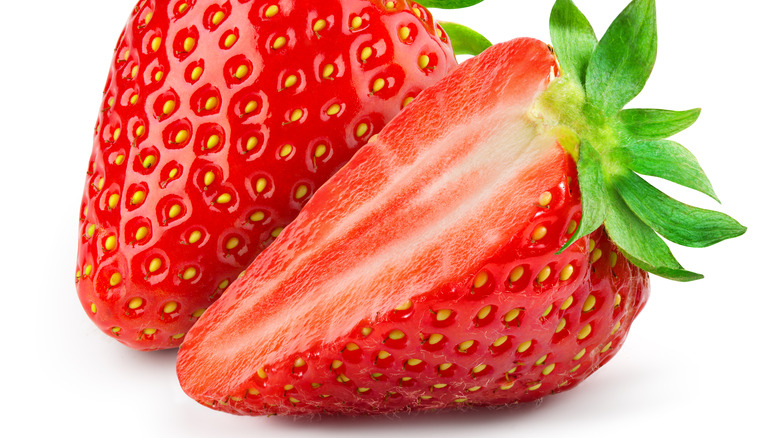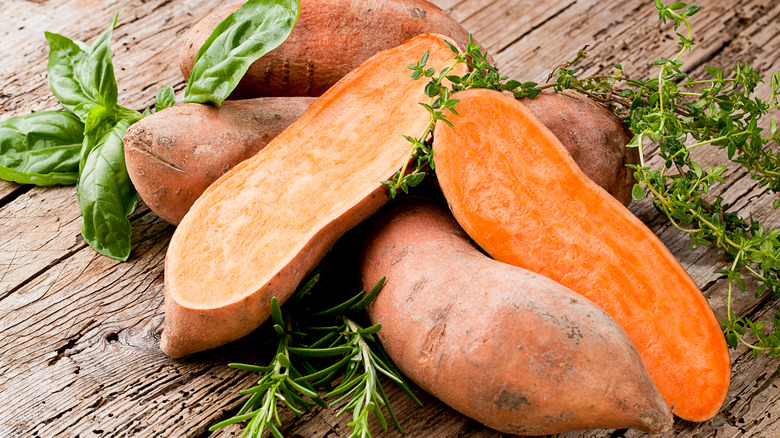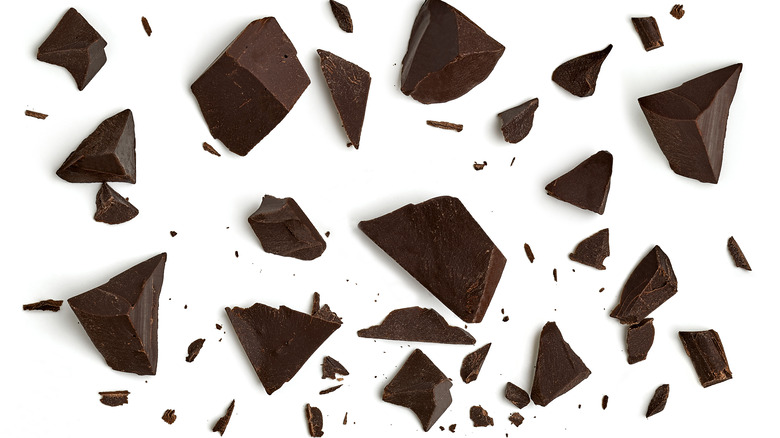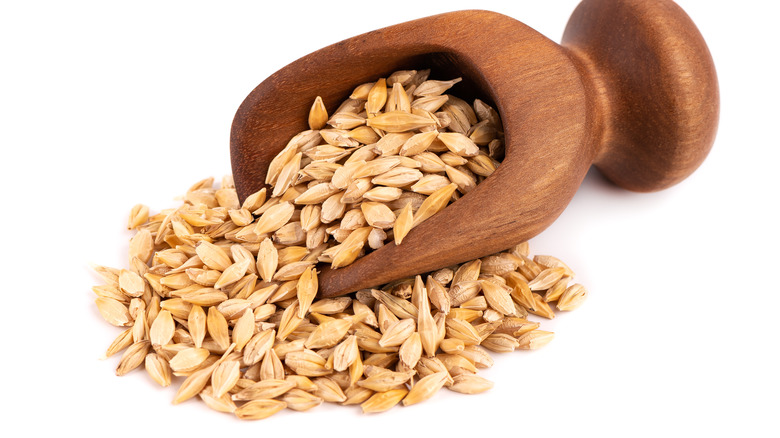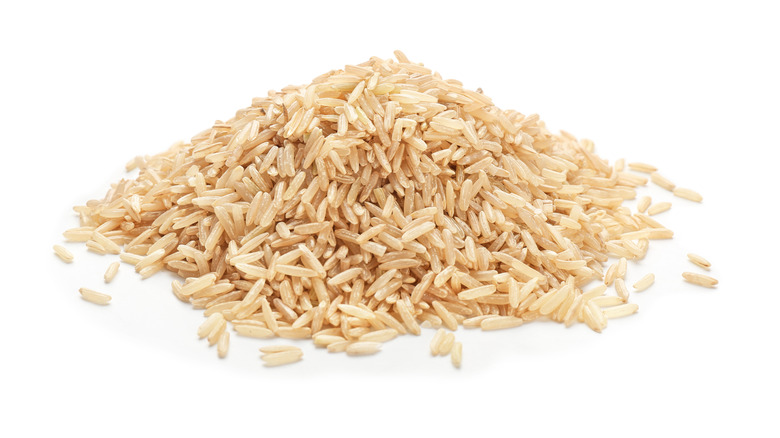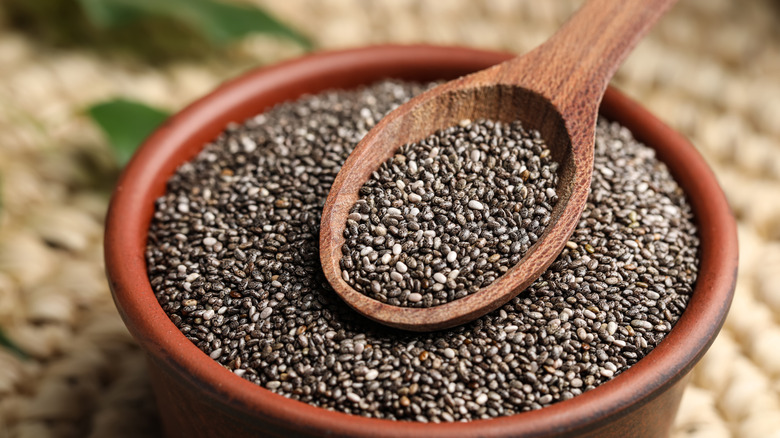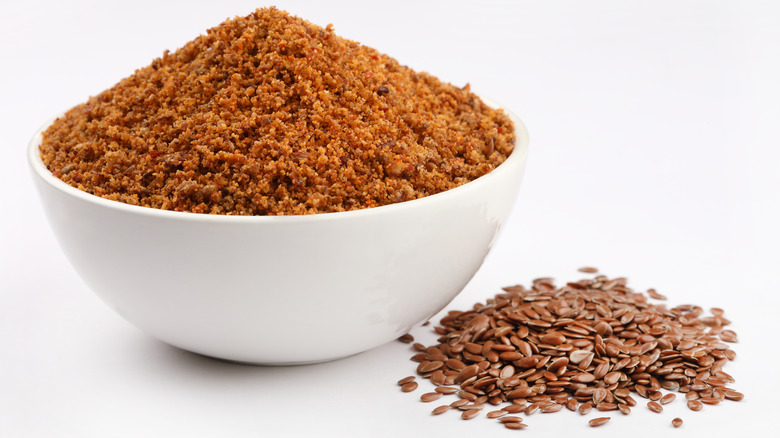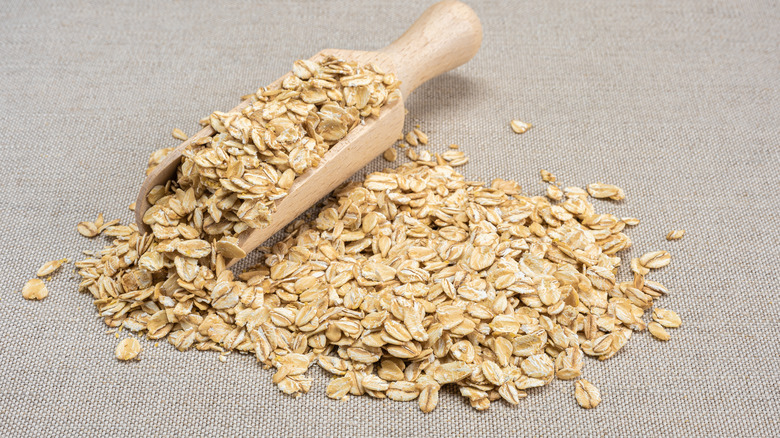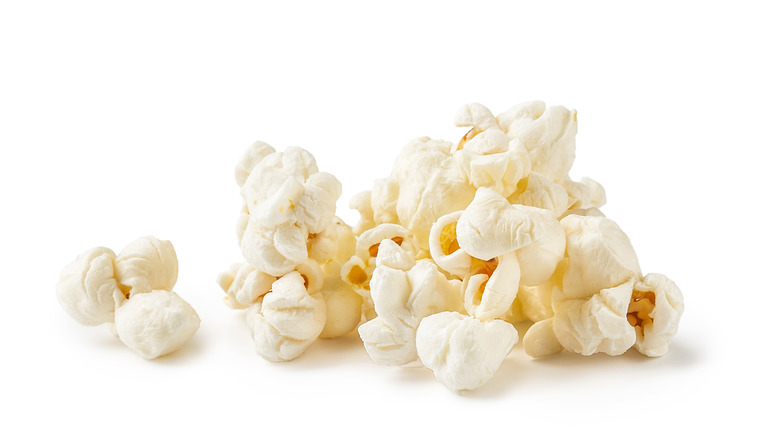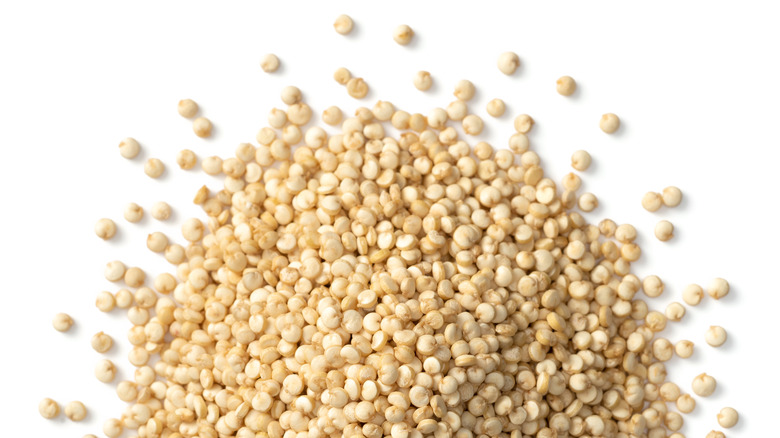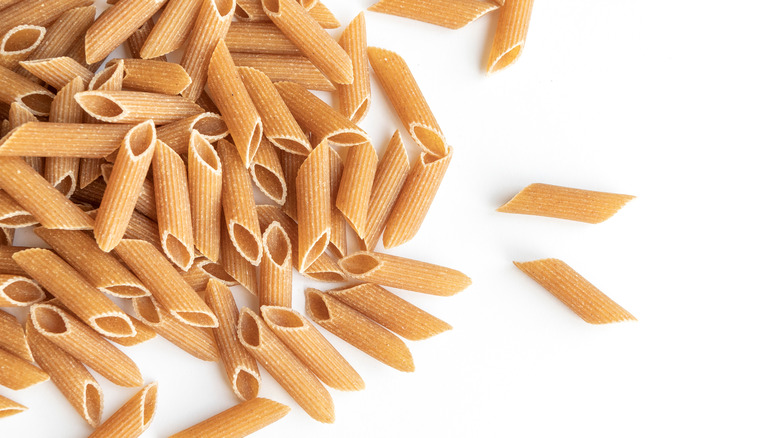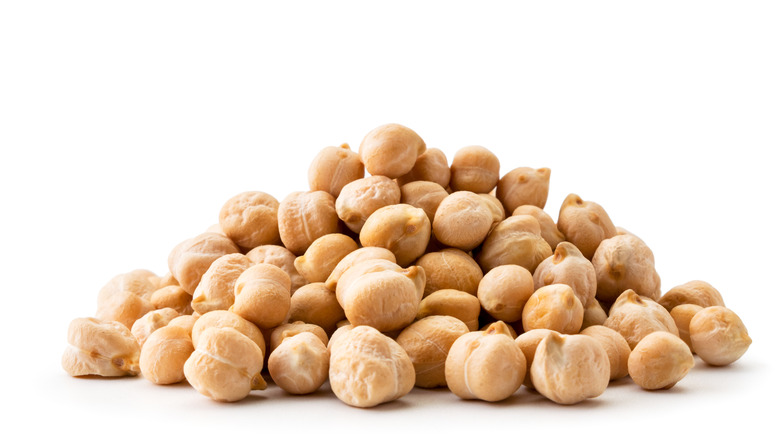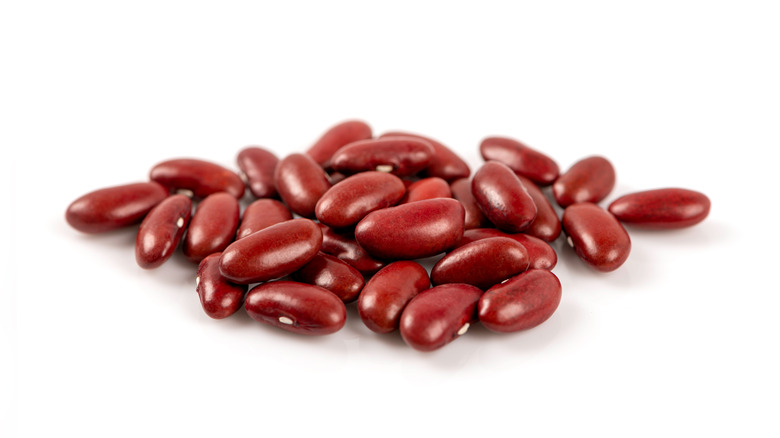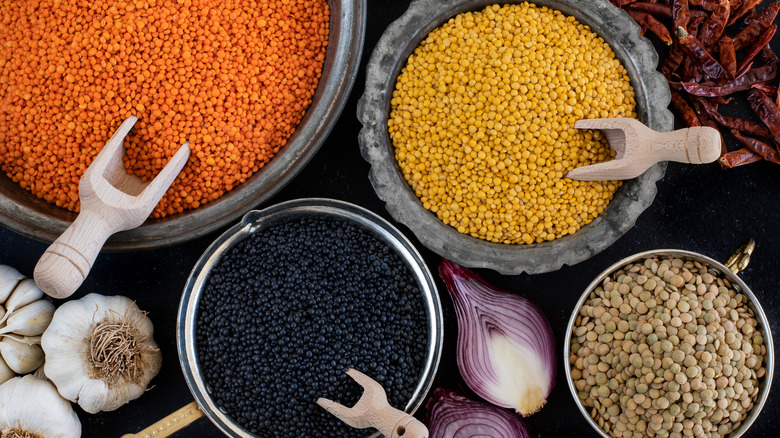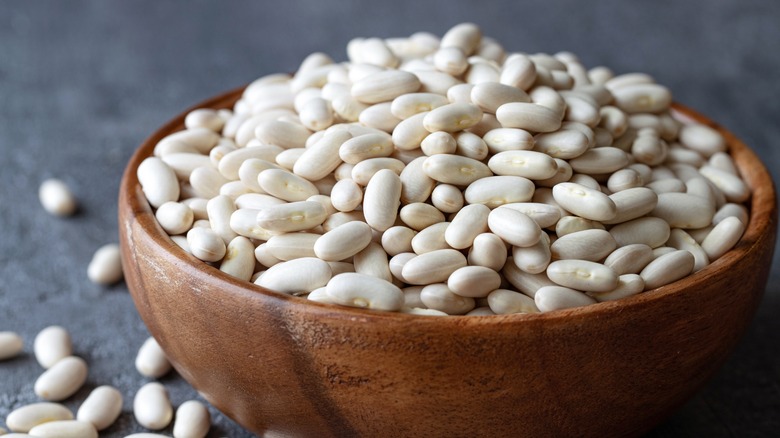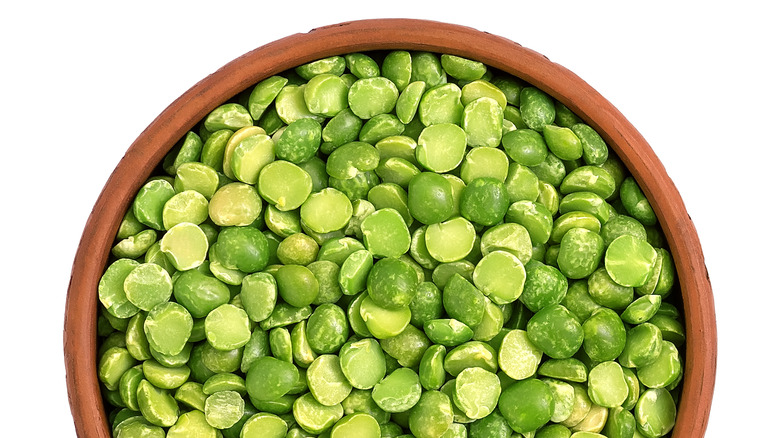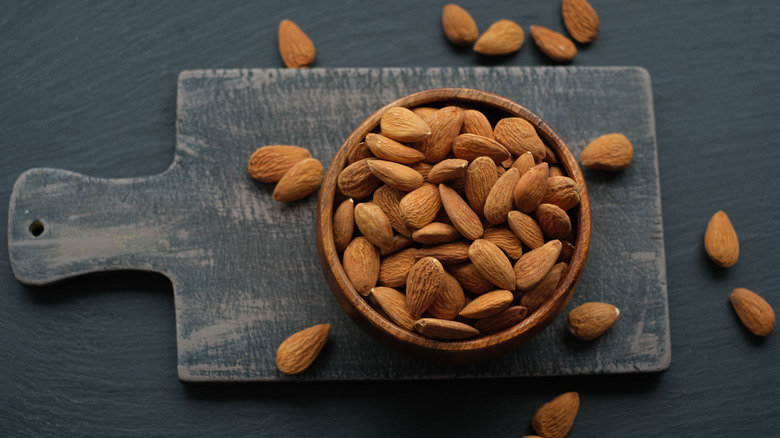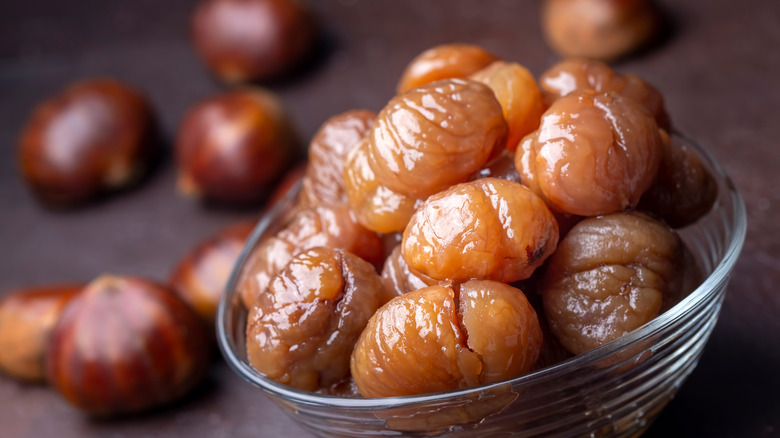31 High-Fiber Foods That Compliment Any Diet
If you've ever eaten a plant-based diet, it's likely someone has asked you, "Where do you get your protein?" But a lack of fiber is just as concerning. According to UCSF Health, the average adult is getting a mere 15 grams a day, as compared to recommendations from the American Heart Association Eating Plan to ingest 25 to 30 grams.
Fiber is essential, according to UCSF Health, for its health benefits link not only to a reduced risk of heart disease, diabetes, and colon cancer, but also, according to Forbes, for improved brain health. More fiber, the outlet reports, has been linked to reduced brain inflammation as well as a lowered risk of memory loss and neurodegenerative diseases. And who wouldn't want that, right?
While there are loads of fiber supplements on the market, as with most things, fiber is best when it comes from food, according to UCSF Health. Luckily, there are loads of great sources to choose from.
Be sure to get a good mix of both soluble and insoluble fiber. The former, according to UCSF Health, can reduce blood cholesterol levels, while the latter serves primarily to promote normal bowel movements. You'll often find both in high-fiber foods, but as a general rule, according to the outlet, the former is more frequently found in fruits, vegetables, and legumes, while the latter is found in edible peels and most whole grains.
Apples
If an apple a day keeps the doctor away, maybe it's because it has so much fiber! One small apple, according to SF Gate, contains about 3.6 grams of fiber, with a balance of about 30% soluble fiber to 70% insoluble ... as long as you eat the skin. Indeed, most of the insoluble fiber in the apple is located in this colorful outside layer (no matter the hue), while 80% of the fiber in the flesh is of the soluble variety.
According to the outlet, apples also boast other important nutrients like vitamin C and potassium. To these benefits, Harvard's T.H. Chan School of Public Health adds a richness in phytochemicals, including anthocyanin, quercetin, and catechin, all of which boast antioxidant properties.
You can boost the fiber content of apples even more by enjoying the apple with other fiber-rich foods. For example, two tablespoons of Jif Extra Chunky Peanut Butter adds about 2 grams of added fiber, via Heb.
Artichokes
The cousin of a thistle, artichokes are known for their incredible richness in fiber: about 10 grams per medium artichoke. According to SFGate, who named U.S. Department of Agriculture (USDA) as their source, that's over a third of your recommended daily intake. Most of the fiber in an artichoke is of the insoluble variety — the kind that keeps things regular.
For the Washingtonian, artichokes aren't just a great choice thanks to the amount of fiber found within them. Indeed, they're also a fantastic source of anti-inflammatory polyphenols. One particular study conducted by the USDA concluded that the vegetable was at the top of the list when it came to its content of antioxidants.
For someone who's never prepared an artichoke before, the prickly veggie could seem a bit difficult to manage. These guides for trimming and cooking artichokes should help!
Consider braising whole baby artichokes with lemon, olive oil, and veggies as in this Greek braised artichoke recipe, or serve them with gluten-free pasta.
Asparagus
Asparagus isn't just rich in soluble fiber, with more than 1 gram per cup of the vegetable, according to LiveScience; The beautiful, flower-like spear also boasts loads of other brain-boosting and anti-inflammatory compounds, including vitamin K and folate. It's also a great source of antioxidant vitamin E, vitamin C, beta carotene, and more. And asparagus is notably rich in asparagine, which one study showed promotes healthy brain function.
While asparagus is certainly filled with nutrients, including fiber, this can contribute to its downfall among diners. Indeed, the combo of fiber and asparagusic acid, reports MedicineNet, can contribute to some slightly unpleasant side effects if you it eat too frequently — notably gassiness and cramping. The outlet nevertheless notes that the vegetable can safely be consumed every day. Give it a try in Sarah Michelle Gellar's baked asparagus fry recipe, or pair it with a fruit- (and fiber-) laced apricot and pine nut romanesco sauce.
Avocado
The Millennial fruit (yup, fruit) of choice, avocados are a perennial favorite for good reason. Not just a great source of delicious healthy fats, just one half of an avocado, according to SFGate, boast over 4 grams of fiber and about two thirds of which is insoluble, per USDA. Seek out Florida avocados if you can: While less common than the California Hass, these jumbo avocados boast almost twice as much fiber, according to the outlet, with nearly 82% of it being of the insoluble variety. And according to LiveStrong, avocados are also rich in vitamin B6, vitamin E, folate, potassium, and niacin.
To kick avocados' in fiber content up even further, pair the smooth, creamy flesh with whole grain bread and sprinkle with chia seeds. The resulting avocado toast is sure to keep you full and satiated all morning — and it also serves as a great mid-afternoon snack.
Bananas
Bananas, according to Healthline, are a good source of fiber, with about 3.1 grams per medium banana. And it's worth noting that those who find brown bananas a bit too soft or slimy are in luck, at least when it comes to this particular nutrient: As Healthline explained, a younger, greener banana has more resistant starch, which aids in the reduction of constipation. Meanwhile, as the banana ripens, these starches transform into sugars, thus lowering its fiber-linked benefits. And greener bananas may also serve as an aid in insulin sensitivity, says Healthline, and improve the health of one's kidneys.
Bananas are delicious when paired with nut butter for an even more fiber-rich treat. Consider spreading a slice of whole wheat toast with your favorite nut butter and topping it with sliced bananas. Sprinkle with some cinnamon for flavor and to reap even more benefits for blood sugar, again, according to Healthline.
Beets
Beautiful, colorful beets are a true nutritional powerhouse, known, according to Healthline, for their richness in minerals like manganese, potassium, and iron as well as vitamins like folate and vitamin C. Beets, the outlet asserts, also have the compound betanin, a pigment that is believed to boast several health benefits, including antioxidant activity that may reduce the risk of DNA damage, according to a research review in Molecular Nutrition & Food Research.
And in case that wasn't enough, Healthline shares, beets are also rich in inorganic nitrate, which is good for heart health. And of course, beets also have a hefty dose of fiber with 2 grams for every 3.5-ounce serving of boiled beetroot you consume.
Beets are delicious roasted as a side or atop a salad. Or for something a little bit different, dig into a chewy beet salad made by dehydrating roasted beets for phenomenal texture and ultra-concentrated flavor.
Blueberries
It's no secret that blueberries are a true blue superfood, loaded with antioxidants, including anthocyanin (via Mayo Clinic Health System), which is responsible not just for the berries' deep blue color but also for their powerful anti-inflammatory properties, as well as their role in increasing immune function and protecting you from heart disease, cancer, and even dementia. Blueberries are also rich in fiber, according to Healthline, with about 2.4 grams per 3.5-ounce serving. Enjoy them plain or atop your favorite breakfast cereal, from oatmeal to granola.
Although some fruits and vegetables lose some of their nutrients when cooked, Dr. Andrew Weil, M.D. revealed that doing so to blueberries doesn't have any effect on the benefits they offer. So you can feel free to enjoy them in muffins and pies. And, while you shouldn't mistake these fat- and sugar-laden treats for health foods, some whole wheat flour makes either one a more fiber-rich treat for sure, according to SFGate.
Broccoli
Cruciferous star veggie broccoli is known for its rich bounty of nutrients, ranging from vitamin C to vitamin K, from iron to potassium. But broccoli is also filled with fiber, according to Healthline, with 2.4 grams per raw, 1-cup serving. And according to SFGate, how you enjoy your broccoli matters, especially when it comes to fiber. While raw broccoli is certainly delicious and nutritious, cooked broccoli boasts an even higher fiber load than raw, with 5 grams of dietary fiber in every cup of steamed broccoli. And according to research, steaming broccoli can preserve its other nutrients as well.
In addition to fiber, vitamins, and minerals, broccoli is also rich in a little-known phytonutrient called sulforaphane, which Healthline reports has antidiabetic and anti-cancer properties and can even help protect one's skin from being damaged by the sun. Enjoy steamed broccoli plain or stir-fried with sesame seeds for even more flavor and crunch.
Brussels sprouts
Brussels sprouts are rich in essential micronutrients like vitamin C and vitamin K. Brussels sprouts also boast anti-cancer benefits thanks to the presence of phytonutrients like sulforaphane and isothiocyanates.
In terms of fiber specifically, Brussels sprouts boast about 2 grams per half cup of the cooked vegetable, according to Healthline, something that VeryWell Fit claims can heal body tissues, boost the immune system, and help strengthen bones. And since Brussels sprouts have a nearly even split between soluble and insoluble fiber, according to SF Gate, you benefit from both the potential to lower bad cholesterol and improved digestion.
Enjoy raw Brussels sprouts paired with fiber-rich pecans in a salad, or enjoy them roasted and tossed with avocado, which is packed not just with fiber but also with healthy monounsaturated fats, according to studies. Either way, these baby cabbages are sure to make your gut both happy and healthy.
Carrots
Carrots are rich in fiber, with about 4 grams per cup of raw carrots, according to SFGate. And boiling carrots only increases the bioavailability of their fiber, with about 5 grams per cup of cooked carrots, according to the outlet.
The root vegetable also boasts loads of other nutrients, including vitamin K, potassium, vitamin B6, and beta carotene, the latter of which isn't just responsible for carrots' beautiful orange color; It also promotes eye health and even, according to the Smithsonian, was at the heart of a World War II-era myth claiming that the veggie could give you night-vision.
Even if carrots don't actually give you superpowers, they may, according to Healthline, contribute to weight loss, lower blood cholesterol, reduced risk of cancer, and, yes, improved eye health. Enjoy them grated into a salad or charred with gooey Brie for a delicious side dish boasting loads of benefits and flavor.
Peas
For such a tiny vegetable, the humble green pea boasts loads of nutritional benefits. According to WebMD, this legume boasts vitamin A, vitamin B1, vitamin B6, vitamin C, and vitamin K, as well as heaps of plant-based protein, and, of course, loads of fiber.
According to Healthline, green peas contain a whopping 4 grams of fiber per 1/2 cup serving, and since they contain the same amount of protein, they're an awesome choice to help keep you full, especially for those veering towards a vegetarian or flexitarian diet. Enjoy peas paired with fellow fiber-rich green veggie avocado in a spring pea guacamole boasting loads of flavor, nutrients, and bright color. Or simply toss frozen peas (just as healthy and even more flavorful, according to EatingWell) with your favorite whole wheat pasta and a dollop of store-bought pesto for a delicious weeknight dinner that's on the table in mere minutes.
Pears
Pears may not be quite as popular as apples, but as compared to their cousins, pears boast even more fiber, with a whopping 5.5 grams of the nutrient per medium pear, as compared to 4.4 for a medium apple, according to SFGate. As with any fruit with an edible peel, eating pears whole rather than peeled means you're getting even more fiber, especially the insoluble kind, according to Fosters Daily Democrat.
In addition to fiber, according to Medical News Today, pears are loaded in vitamins C and K as well as minerals like potassium. Consider pairing pears with other fiber-rich foods, such as pecans, beets, and lettuces to make a delicious sweet-and-savory salad that's tasty, healthy, and filling. Pears are also a lovely accompaniment to a cheese board, marrying particularly well with blue cheeses, feta, and goat cheese, according to Chelan Fresh. Nuts like pecans or walnuts and whole wheat crackers make this tasty combo a fairly fiber-filled snack option perfect for entertaining.
Persimmons
If you've never tried a persimmon, now's the time. This luscious orange fruit has vitamins C and A, according to WebMD, but it's also particularly filled with soluble fiber, with a whopping 6 grams per fruit. One study cited by WebMD found that due to this richness in the nutrient, eating persimmons is an excellent way to lower cholesterol. Medical News Today adds that persimmons are also particularly rich in potassium, an essential mineral that can reduce the risk of stroke, according to Harvard Health.
There are two major varieties of persimmon, according to Serious Eats: the non-astringent variety, of which the most common cultivar is Fuyu, and the astringent variety, of which the most common in the U.S. is Hachiya. Both are delicious, though the astringent ones need to be very ripe to enjoy. Amelia Saltsman, author of "The Santa Monica Farmers' Market Cookbook," recommends enjoying Fuyus in a salad with toasted pecans and a simple, lemony vinaigrette to reap all of their benefits and best appreciate their flavor.
Strawberries
Like other berries, strawberries, according to SFGate, are fairly rich in fiber, with 2 grams of the nutrient in a serving of eight medium berries. This fiber is fairly evenly divided between soluble and insoluble, with 40% of the former and 60% of the latter.
According to Healthline, fiber isn't the only reason you should be upping your strawberry intake. Strawberries, according to the outlet, are a great source of other nutrients like vitamin C and manganese, and they also have antioxidants, which, according to the Mayo Clinic, reduce the effects of free radicals on the body's cells, thus diminishing the risk of certain diseases.
Enjoy strawberries on their own as a tasty snack, sliced into salads with greens or fruits, or pair them with Greek yogurt and granola made with soluble fiber-rich oats for a delicious breakfast parfait sure to keep you full and satiated all morning long.
Sweet potato
Sweet potatoes have recently surged in popularity as compared to their classic cousins. Not only do sweet potatoes deliver a more nutrient-dense French fry, the orange root veg has also proven an excellent lower-carb stand-in for bread in breakfast options like gluten-free sweet potato toast. And these swaps are well worth the added effort: Not only is sweet potato tasty, but according to WebMD, sweet potatoes are an excellent source of nutrients like beta carotene (particularly in the case of orange varieties) as well as anthocyanin (in the case of purple). Either color boasts loads of fiber, with about 3 grams of the stuff in a half cup of cooked sweet potatoes.
SFGate notes that the balance of soluble and insoluble fiber in a sweet potato is fairly similar, and you get even more by enjoying the skin. (Give it a good scrub, first) Consider serving sweet potatoes as a sweeter alternative to a baked or jacket potato, stuffed with fillings like broccoli or onion.
Dark chocolate
No, you're not dreaming. Dark chocolate does indeed contain fiber. According to Self, one 100-gram bar of dark chocolate (about 3.5 ounces) contains an incredible 11 grams of the nutrient.
Fiber joins a host of other health benefits of this sweet favorite, according to WebMD, which cites antioxidant and anti-inflammatory properties as another added bonus of indulging in the superfood.
But not all dark chocolate is created alike. As BBC explains, there's no strict definition for how much cocoa a chocolate needs to contain to be labeled dark, so it's best to seek out brands that openly display the percentage of cocoa in the bar. For the most part, the darker the chocolate, the less added sugar it will contain, and the healthier a choice it is; BBC recommends looking for dark chocolate without any added flavorings and sticking to the darkest variety you can (bearing in mind that you shouldn't be suffering through the bitterness, either) An occasional 20-gram portion of dark chocolate is, according to the outlet, a great addition to a balanced diet. Chop your dark chocolate into shards and stir it into your favorite granola recipe for even more fiber thanks to the oats, nuts, and seeds. Or simply indulge in a square of the good stuff all on its own for a moment of pure pleasure.
Barley
Whole grains are an excellent source of fiber, particularly of the soluble kind, and barley is a good choice. According to a 2017 report in the American Journal of Lifestyle Medicine, barley contains a whopping 17.3 grams of fiber per 100 grams, which is more than more than rye (15.1 grams), bulgur (12.5 grams), or wheat (12.2 grams). Barley also contains about two-thirds more fiber as oats, according to Life Extension Magazine, while, according to Montana State University, also boasting a high amount of beta-glucans, the compound found in oats that has been shown to lower bad cholesterol.
Barley is sold in several different forms, and given the choice, hulled barley has more fiber than pearled barley, via Ideal Green Market, as the latter, more common form of the grain has had both its hull and bran removed. That said, either is a healthful choice and can be prepared in hearty recipes like mushroom and barley soup.
Brown rice
As compared to white rice, brown rice is richer in quite a few nutrients, according to Verywell Fit, including amino acids, vitamins, flavonoids, and, of course, fiber. This is because what makes brown rice brown is the presence of the bran layers typically stripped to reveal the white grain within, and most of the beneficial compounds in the grain reside in these outer layers.
According to the outlet, cooked brown rice contains 3.51 grams of fiber in each 1-cup serving of the food, which is more than twice as much as white rice (per Health). SFGate dubs brown rice as a great source of insoluble fiber, noting that including it in your diet can help contribute to better digestion and relieve constipation. And a study found that brown rice is a great source of antioxidants, making brown rice one of many anti-cancer foods, according to the Mayo Clinic.
Chia seeds
The tiny seeds that launched a million "pets" (and an ear worm of a jingle that just wouldn't quit), chia seeds are a nutritional powerhouse that are particularly lauded as the richest plant-based source of good-for-you omega-3 fatty acids, according to Harvard's T.H. Chan School of Public Health. These compounds, according to the outlet, have been proven to benefit heart health and decrease inflammation.
Chia seeds are also rich in fiber, according to the outlet, a characteristic that could contribute to even more potent cholesterol-lowering properties than omega-3 fatty acids alone. Chiefly of the soluble variety, chia seeds' fiber also helps to keep you full and may prevent blood sugar spikes; Medical News Today notes that thanks to this latter ability, chia could be a good choice for those with type 2 diabetes.
Try chia seeds sprinkled on your avocado toast, or take advantage of their miraculous thickening powers by stirring up a pomegranate chia pudding or one with coconut. You can also enjoy the seeds in a tasty chia tonic.
Flaxseed
Flaxseed is filled with nutrients, according to Medical News Today, which cites it as a "functional food" thanks to its richness in cancer-fighting antioxidants, specifically lignans, as well as potentially anti-carcinogenic omega-3 fatty acids.
And of course, flaxseed is also rich in fiber, specifically insoluble fiber, according to the outlet. The National Center for Complementary and Integrative Health notes, nevertheless, that consuming flaxseed without adequate water may have effects counter to the desired outcome, with the potential to worsen constipation and even lead to intestinal blockage. To best reap the benefits of flaxseed, according to The Mayo Clinic, it's best not only to accompany it with a big glass of water, but to grind it into a meal or powder first. Whole seeds, according to the Clinic, can pass through the intestine undigested, leaving their incredible benefits untapped.
Ground flaxseed can slip nearly unnoticed into porridge, cereal, sauces, breads, and more, to make these and other dishes even more nutritious and up their fiber content seamlessly.
Oatmeal
Oatmeal has long been touted as a beloved high-fiber breakfast option, particularly thanks to its beta-glucan soluble fiber, which, according to Harvard's T.H. Chan School of Public Health, may contribute to a reduced risk of coronary heart disease. SFGate explains that this type of fiber is also what contributes to oatmeal's cholesterol-managing superpowers, as it is believed to turn into a gel during digestion, stick to bile acids, and carry them out of one's body. The body, the outlet explains, then pulls cholesterol from the blood to replace this bile, thus lowering overall cholesterol levels.
And that's not all; This soluble fiber, according to Harvard, may also contribute to improved weight loss, as it can increase feelings of fullness. It's no wonder it's such a stalwart breakfast fave.
Oats, Harvard explains, can be sold in several forms, with less processed versions, like steel-cut oats or whole oat groats, taking a longer time to digest and thus boasting a lower glycemic index. As compared to more processed versions, like rolled or old-fashioned oats, these oats also take longer to cook, but if you've got the time, the added benefits are well worth the extra effort.
Popcorn
If you're looking for a better-for-you snack to enjoy in front of your evening Netflix binges, it's tough to find a better option than popcorn. A three-cup serving of air-popped popcorn contains 4 grams of fiber, according to SFGate, and as long as you keep toppings and seasonings to a minimum, it's a filling, somewhat low-calorie snack (with about 100 calories in three cups).
A drizzle of heart-healthy olive oil accompanied by a sprinkle of nutritional yeast, rich in all nine essential amino acids, as well as essential vitamins and minerals, will make your snack even healthier (via WebMd). You could also sprinkle your popcorn with turmeric and black pepper, which don't just lend it a gorgeous yellow hue and a slight scent of curry, but also work in tandem, according to Healthline, to reduce general inflammation in the body. Or for something slightly sweeter, choose cinnamon (with or without a touch of sugar). Cinnamon according to Healthline, may help lower blood sugar and reduce the urge to mindlessly eat.
Quinoa
Quinoa emerged as a superfood several years ago, and it's not hard to see why: Boasting all of the benefits of both whole grains and protein-rich seeds, this pseudo-grain (technically the seed of a plant more closely related to beets or spinach than true grains like wheat or oats, according to Medical News Today) is naturally devoid of gluten while also being rich in essential minerals like manganese, magnesium, and phosphorus, as well as vitamins like folate and vitamin B1 (via Harvard's T.H. Chan School of Public Health). And of course, quinoa is rich in fiber, boasting 5.18 grams of it in every cup of cooked quinoa.
And since quinoa is rich in protein too, with just over 8 grams per cooked cup, as well as lysine, an essential amino acid for the synthesis of the aforementioned protein, it's the ideal base for many a meatless meal. Choose it in place of rice as a fiber- and protein-rich base for burrito bowls, or serve it with your favorite tomato sauce as a stand-in for pasta.
Whole wheat pasta
Whole wheat is a much more nutrient-dense option than white, especially when it comes to fiber. As compared to regular cooked pasta, explains SFGate, whole wheat pasta contains 60% more fiber, with 6.3 grams per 1-cup serving, as compared to just 2.5 grams per 1-cup serving of white pasta.
But it's not as though they are completely different entities. In fact, much like rice, the brown version is simply the more raw version of the two, with its outer and most nutrient-rich layer, which features nutrients like vitamin B, vitamin E, and fiber, intact, as WebMD explained, as the white version is stripped down. Whole wheat pasta retains these nutrients and is therefore a healthier option boasting a lovely, nutty flavor.
Simply swapping trading in your white pasta for whole wheat, WebMD shared, can contribute to better weight management (due, in part, to more sustained feelings of fullness), and improved digestive health.
Chickpeas
Beans and legumes tend to be a great source of fiber, and chickpeas (also known as garbanzo beans) are no exception. Boasting amylose starch, which is slow to digest, as well as a low glycemic index, this pulse can help keep your blood sugar low. And, thanks to their richness in soluble raffinose fiber, with a whopping 12.5 total grams per cup of cooked chickpeas, according to SFGate, they keep digestion regular and consistent, according to WebMD. And if better bowel movements weren't already making you happier, chickpeas' richness in choline, the outlet adds, can improve not just your mood, but your memory.
Chickpeas, WebMD adds, are also rich in other minerals like calcium and magnesium. Pair them with other fiber-rich ingredients like lentils and rice in a delicious Indian dal, toss them with (whole wheat) pasta for a tasty pasta e ceci, or enjoy them simply seasoned and toasted for a crunchy chickpea snack.
Kidney beans
If you like beans in your chili, kidney beans are a perennial fave — and it's not hard to see why. With their reddish skin revealing a creamy yet toothsome interior, kidney beans are nothing if not delicious. And they're also an excellent source of fiber. According to Healthline, one 3.5-ounce portion of boiled kidney beans contains about 6.4 grams of fiber. When combined with the portion's nearly 9 grams of protein, kidney beans don't just keep you fuller longer; they may, the outlet contends, help with weight management.
A word of warning, however, to those tempted to serve up vegan three-bean chili or New Orleans-style red beans and rice on a first date: The alpha-galactoside insoluble fiber found in kidney beans can cause digestive distress in some people (via Healthline). Like all beans, kidney beans also contain phytohaemagglutinin, a toxin that can cause nausea and vomiting, according to WebMD. The toxin cooks out (otherwise there would be a lot of very ill people), but since kidney beans have more of this toxin than any other kind of bean, it's best to make sure you cook them very thoroughly before digging in.
Lentils
Little lentils pack a big nutrient punch, boasting a variety of nutrients including B vitamins as well as minerals like magnesium and zinc, according to Healthline. Lentils also contain about 18 grams of protein and more than 15 grams of fiber per 1-cup serving, depending on the variety you're using — and there are loads, with colors including green, brown, coral, and yellow, each of which boasts a different texture, from the toothsome, mottled grey-and-green lentils from France's Auvergne region to the soft, tender coral lentils so beloved in soups and dals. (According to WebMD, experts point to green lentils as the healthiest of the lot, but honestly, it's hard to go wrong, as long as you like what you're eating).
Lentils also boast powerful polyphenols, according to the outlet, and some studies have even shown that lentils can improve blood sugar levels. Enjoy them with pasta, in soups, or in a delicious spiced dal accompanied by brown rice if you need an even bigger fiber boost.
Navy beans
Of all members of the bean and legume family, navy beans may be the biggest fiber powerhouse. According to SFGate, navy beans boast almost 10 grams of fiber per 1/2-cup serving, more than any other variety including pinto, kidney, adzuki, mung, and black beans (all of which, the outlet contends, have at least 8 grams of fiber in the same serving size), making them good alternatives, but nowhere near as rich in the nutrient. Navy beans, like other beans, are also rich in B vitamins and with their impressive protein profile, they're a must for anyone following a plant-based diet.
Enjoy navy beans in an aromatic pasta e fagioli (use whole wheat pasta for even more fiber), or simmer them in a flavorful Persian noodle soup alongside other fiber-rich pulses like brown lentils and fava beans. You can also add them to salads to up the fiber and protein content.
Split peas
Often confused with lentils, split peas are a hearty addition to many dishes in which you'd commonly find the smaller pulse, such as Indian dals or soups. According to LiveStrong, split peas are slightly poorer than lentils in some major nutrients like iron and protein. And while certainly rich in fiber, they don't quite stack up to their cousins, with just 6 grams of fiber per cup as compared to the 15.6 grams provided by lentils. That said, they do boast similar levels of potassium, and they're a delicious, comparable stand-in if you want to change up your legume habits.
Split peas are available in both yellow and green forms. The latter is more traditional in a classic, warming split pea soup recipe, but either would be a welcome addition to this peas and greens dish, paired with nutrient-dense greens and garlic in a topped with umami-rich Parmesan cheese.
Almonds
While all nuts are rich in fiber, almonds are a particularly good choice, boasting 3.3 grams per 30-gram serving (about a handful) according to Nuts for Life, as compared to cashews, with have just 1.8 grams. Skin-on almonds aren't just tastier; they're also far richer in this essential nutrient. Almonds, according to the outlet, outrank hazelnuts, pistachios, pecans, and macadamia nuts in terms of fiber content.
According to the BBC, almonds are rich in healthy, unsaturated fats and minerals like magnesium, copper, and manganese. And almonds are also a good source of vitamin E, an immune system essential, according to the NHS, which contributes to improved eye and skin health. And research, the BBC notes, has linked almonds to improved blood sugar management and weight management, not to mention reduced risk of heart disease.
Almonds can be enjoyed on their own or ground into an almond butter; The latter is more easily paired, perhaps, with fiber-rich fruits like apples or bananas, while the former is welcome in salads or atop hot cereal like oatmeal.
Chestnuts
Chestnuts aren't just for roasting over an open fire: These nuts contain more fiber, even, than almonds, with a whopping 4.5 grams of the nutrient per 30-gram serving, according to Nuts for Life (as compared, for example, to 3.3 for almonds, 3.1 for hazelnuts, or a mere 1.9 for walnuts).
According to one report, chestnuts are also lower in fat than any other nut. And while the fat in nuts is the heart-healthy monounsaturated kind, if you're looking to cut back, they're a great choice.
Also unlike other nuts, according to WebMD, chestnuts are rich in vitamin C and other antioxidants, and they contain minerals like magnesium and potassium to boot. Enjoy them as a filling for a delicious homemade agnolotti pasta (with or without truffles) or blitz them into a delicious chestnut soup seasoned with caraway. (Or just snack on them as you'll traditionally find them at European Christmas markets: roasted right in their hard shells)
